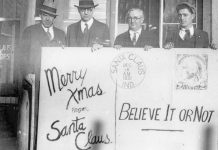Opioid Crisis ‘Kingpin’ Is Oklahoma’s New Target in Lawsuit
After securing a hefty financial settlement from Purdue Pharma last month, Oklahoma Attorney General Mike Hunter is training the state’s legal armaments on a much bigger pharmaceutical player: Johnson & Johnson.
The company already has become a popular target. Many of the more than 1,600 opioid lawsuits in state and federal courts name Johnson & Johnson, even though its analgesic products account for less than 1% of the U.S. opioid market.
But Oklahoma might be charting new legal territory in its recent salvo against the multinational manufacturer of drugs, medical devices and popular brands of baby shampoo and baby powder.
Hoping to unseal millions of pages of company documents, Oklahoma’s lawyers contend that Johnson & Johnson did more than push its own pills — it also profited from the prescription opioid crisis through its ownership of a poppy producer in Australia (Tasmanian Alkaloids) and a U.S. importer of raw materials used to make opioids (Noramco).
Johnson & Johnson’s painkiller brands included Duragesic, Nucynta and Nucynta ER. The company sold its rights to Nucynta products in 2015.
“The public disclosure of Purdue’s sinister actions is a drop in the bucket compared to the evidence generated in this litigation, demonstrating precisely how J&J—a ‘family company’—acted as the kingpin behind this Public Health Emergency,†Oklahoma’s attorneys wrote in a February court filing.
With the Oklahoma legislature scheduled to end its session May 31, three days after the opioid trial is slated to begin at the courthouse in Norman, the state’s attorneys argue that the need to publicly disclose Johnson & Johnson documents is urgent.
“The Legislature most certainly deserves to be fully informed of the facts revealed in this litigation in order to continue its urgent efforts to fight this Public Health Emergency,†according to the motion.
Oklahoma District Judge Thad Balkman has not yet responded to the state’s motion to unseal the documents.
“Our Legislature, Governor, policymakers and doctors need to know the truth about how one particular company, J&J, inserted itself into our State and sought to influence every opioid-related decision the State made or considered—from scheduling to swallowing,†attorneys for Oklahoma wrote. The documents also would be made available to the public.
Among the questions Oklahoma wants answered is whether Johnson & Johnson’s marketing targeted children, veterans or the elderly. The motion also asks whether the company blocked legislation and regulatory action aimed at limiting opioid availability, whether it partnered with Purdue, and whether it paid “‘neutral’ third parties as part of its internal marketing plan.â€
Hunter and the outside lawyers representing Oklahoma declined several interview requests.
In its own filing, Johnson & Johnson — which divested both Tasmanian Alkaloids and Noramco in 2016 — argues that Oklahoma’s goal in seeking to unseal the documents is to “batter Oklahomans with sensationalistic headlines and to poison potential jurors†against its opioid unit, Janssen Pharmaceuticals, in advance of the May 28 trial.
Janssen dismissed Oklahoma’s charge that the company’s ownership of poppy fields made it a conspirator in the opioid epidemic.
“As a supplier, we did not have any role in the manufacturing, development, sales and marketing of other manufacturers’ finished products,†Janssen said in a statement emailed by a spokesman to Stateline. “The allegations made against our company are baseless and unsubstantiated.â€
The company also noted that it complied fully with strict U.S. Drug Enforcement Administration controls in importing poppy straw and other raw materials used to produce opioid anesthesia and pain medicines.
Legal experts said other states might follow Oklahoma’s lead, but that it will be difficult to prove that Johnson & Johnson’s poppy fields made it a major contributor to the opioid epidemic.
University of Kentucky law professor Richard Ausness called Oklahoma’s strategy “over the top.â€
“The only way Oklahoma could win that case is to prove some kind of conspiracy. It looks more like they are trying to browbeat Johnson & Johnson into settling,†Ausness said.
“I can see why J&J would be particularly susceptible to that kind of pressure because they sell consumer products and they’re considered a family company,†he said. “If they’re painted as a villain, that’s obviously going to hurt them.â€
Until recently, the state and federal opioid lawsuits across the country mostly targeted Purdue Pharma, the company that developed and profited from OxyContin.
But last month, Purdue Pharma’s president and chief executive, Craig Landau, told theWashington Post that the company might pursue a Chapter 11 bankruptcy claim, a maneuver that could halt litigation against it. Now, many of the plaintiffs in a consolidated national case in the U.S. District Court for the Northern District of Ohio — the National Prescription Opiate Litigation — also are suing the Sackler family, which owns the company.
Recent court filings in New York and elsewhere contend that Sackler family members — who are worth an estimated $14 billion — were deeply involved in the business decisions that worsened the opioid epidemic.
Those filings followed the release in January of a previously redacted complaint filed by Massachusetts Attorney General Maura Healey in a Superior Court case against Purdue.
In addition to the $270 million Oklahoma got from Purdue, last month’s historic settlement included an additional $75 million commitment from the Sackler family. Of the total, $102.5 million will fund a new addiction treatment and research center at Oklahoma State University in Tulsa.
Another $12.5 million will go to Oklahoma cities, counties and tribes for the damage caused by the opioid epidemic, along with $60 million to reimburse the state for its litigation costs.
With Purdue and the Sackler family out of the picture in the Oklahoma case, the state may be trying to increase Johnson & Johnson’s liability by linking it to Purdue and other drugmakers in an alleged conspiracy, said Case Western Reserve University law professor Andrew Pollis.
Whether Oklahoma can produce documents proving such a conspiracy remains to be seen. In the meantime, “the optics are bad for Johnson & Johnson,†Pollis said. “If they have nothing to hide, why are they trying to hide it?â€




